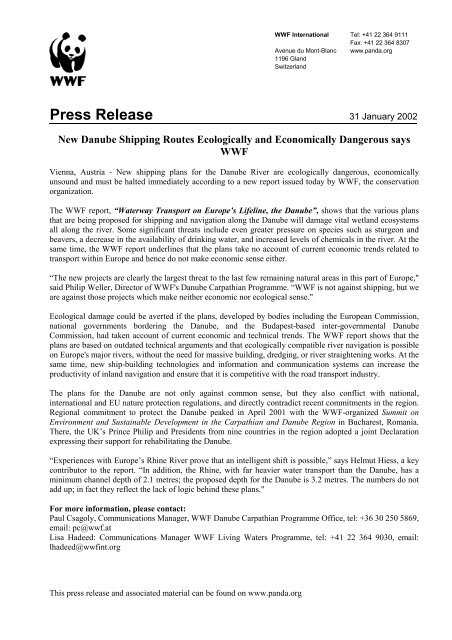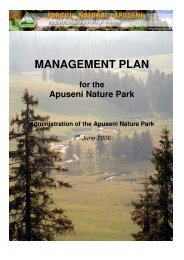WWF Press Release - Zinke Environment Consulting
WWF Press Release - Zinke Environment Consulting
WWF Press Release - Zinke Environment Consulting
Create successful ePaper yourself
Turn your PDF publications into a flip-book with our unique Google optimized e-Paper software.
<strong>WWF</strong> International<br />
Avenue du Mont-Blanc<br />
1196 Gland<br />
Switzerland<br />
Tel: +41 22 364 9111<br />
Fax: +41 22 364 8307<br />
www.panda.org<br />
<strong>Press</strong> <strong>Release</strong> 31 January 2002<br />
New Danube Shipping Routes Ecologically and Economically Dangerous says<br />
<strong>WWF</strong><br />
Vienna, Austria - New shipping plans for the Danube River are ecologically dangerous, economically<br />
unsound and must be halted immediately according to a new report issued today by <strong>WWF</strong>, the conservation<br />
organization.<br />
The <strong>WWF</strong> report, “Waterway Transport on Europe’s Lifeline, the Danube”, shows that the various plans<br />
that are being proposed for shipping and navigation along the Danube will damage vital wetland ecosystems<br />
all along the river. Some significant threats include even greater pressure on species such as sturgeon and<br />
beavers, a decrease in the availability of drinking water, and increased levels of chemicals in the river. At the<br />
same time, the <strong>WWF</strong> report underlines that the plans take no account of current economic trends related to<br />
transport within Europe and hence do not make economic sense either.<br />
“The new projects are clearly the largest threat to the last few remaining natural areas in this part of Europe,"<br />
said Philip Weller, Director of <strong>WWF</strong>'s Danube Carpathian Programme. “<strong>WWF</strong> is not against shipping, but we<br />
are against those projects which make neither economic nor ecological sense."<br />
Ecological damage could be averted if the plans, developed by bodies including the European Commission,<br />
national governments bordering the Danube, and the Budapest-based inter-governmental Danube<br />
Commission, had taken account of current economic and technical trends. The <strong>WWF</strong> report shows that the<br />
plans are based on outdated technical arguments and that ecologically compatible river navigation is possible<br />
on Europe's major rivers, without the need for massive building, dredging, or river straightening works. At the<br />
same time, new ship-building technologies and information and communication systems can increase the<br />
productivity of inland navigation and ensure that it is competitive with the road transport industry.<br />
The plans for the Danube are not only against common sense, but they also conflict with national,<br />
international and EU nature protection regulations, and directly contradict recent commitments in the region.<br />
Regional commitment to protect the Danube peaked in April 2001 with the <strong>WWF</strong>-organized Summit on<br />
<strong>Environment</strong> and Sustainable Development in the Carpathian and Danube Region in Bucharest, Romania.<br />
There, the UK’s Prince Philip and Presidents from nine countries in the region adopted a joint Declaration<br />
expressing their support for rehabilitating the Danube.<br />
“Experiences with Europe’s Rhine River prove that an intelligent shift is possible,” says Helmut Hiess, a key<br />
contributor to the report. “In addition, the Rhine, with far heavier water transport than the Danube, has a<br />
minimum channel depth of 2.1 metres; the proposed depth for the Danube is 3.2 metres. The numbers do not<br />
add up; in fact they reflect the lack of logic behind these plans."<br />
For more information, please contact:<br />
Paul Csagoly, Communications Manager, <strong>WWF</strong> Danube Carpathian Programme Office, tel: +36 30 250 5869,<br />
email: pc@wwf.at<br />
Lisa Hadeed: Communications Manager <strong>WWF</strong> Living Waters Programme, tel: +41 22 364 9030, email:<br />
lhadeed@wwfint.org<br />
This press release and associated material can be found on www.panda.org
Page 2 of 2<br />
Notes to Editors:<br />
To view the press release, a backgrounder, maps, the Executive Summary of the report and the full<br />
Report, go to: www.panda.org/livingwaters and www.panda.org/europe/freshwater.<br />
For more about <strong>WWF</strong>'s Danube Carpathain Programme: www.panda.org/danube-carpathian.<br />
A B-roll showing biodiversity around the river, dams, general shots of the Danube is available from Paul<br />
Csagoly (tel: +36 30 250 5869, email: pc@wwf.at)<br />
More About the Danube<br />
The Danube is an international waterway running 2,414 km from Bavaria to the Danube Delta. It is part of the<br />
Rhine-Main-Danube link between the North Sea and Black Sea. The Danube River Basin is the most<br />
international river basin in the world, draining the lands of 17 countries and home to 80 million people. Some<br />
20 million people depend directly on the basin as a source of clean drinking water.



